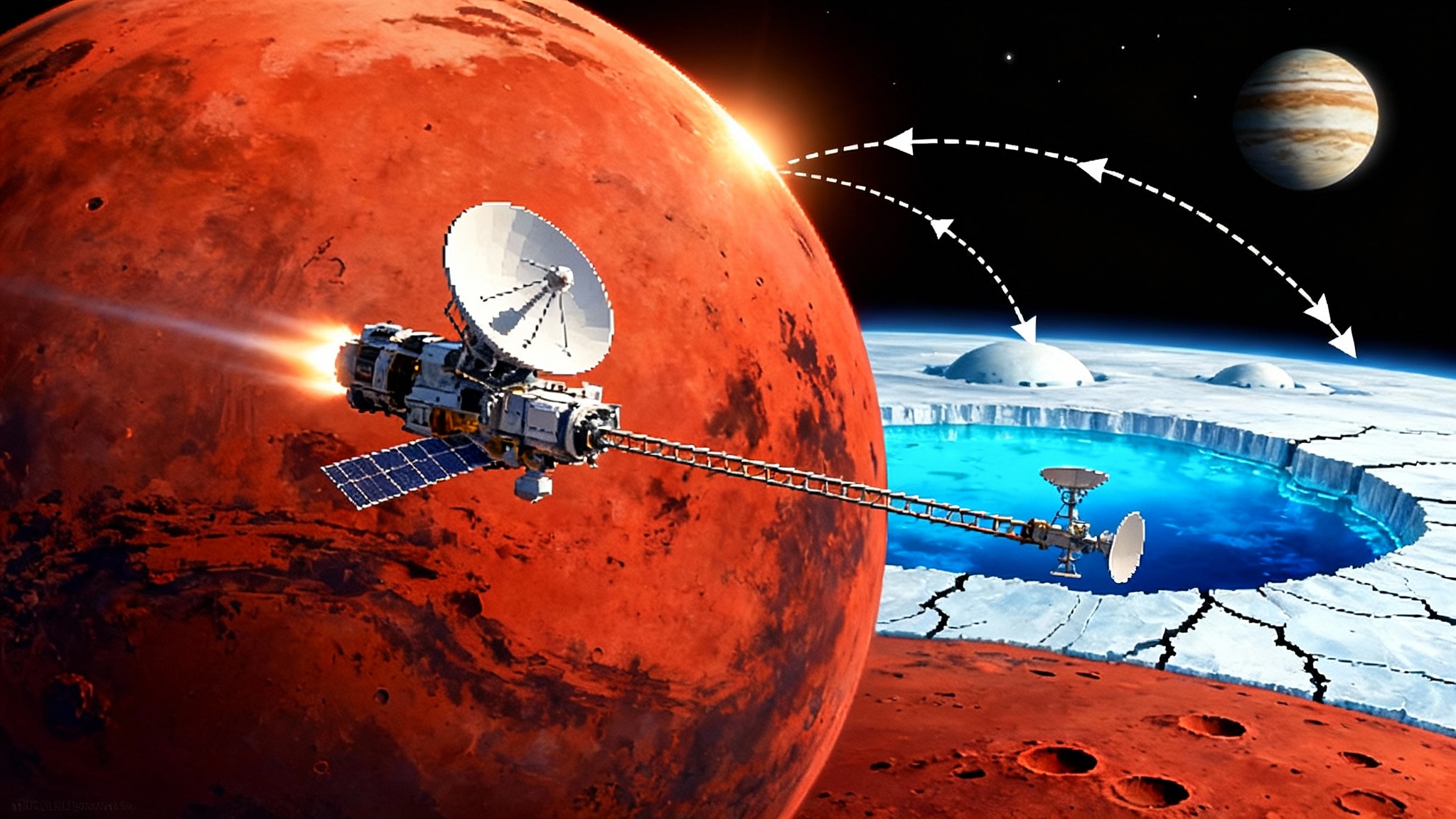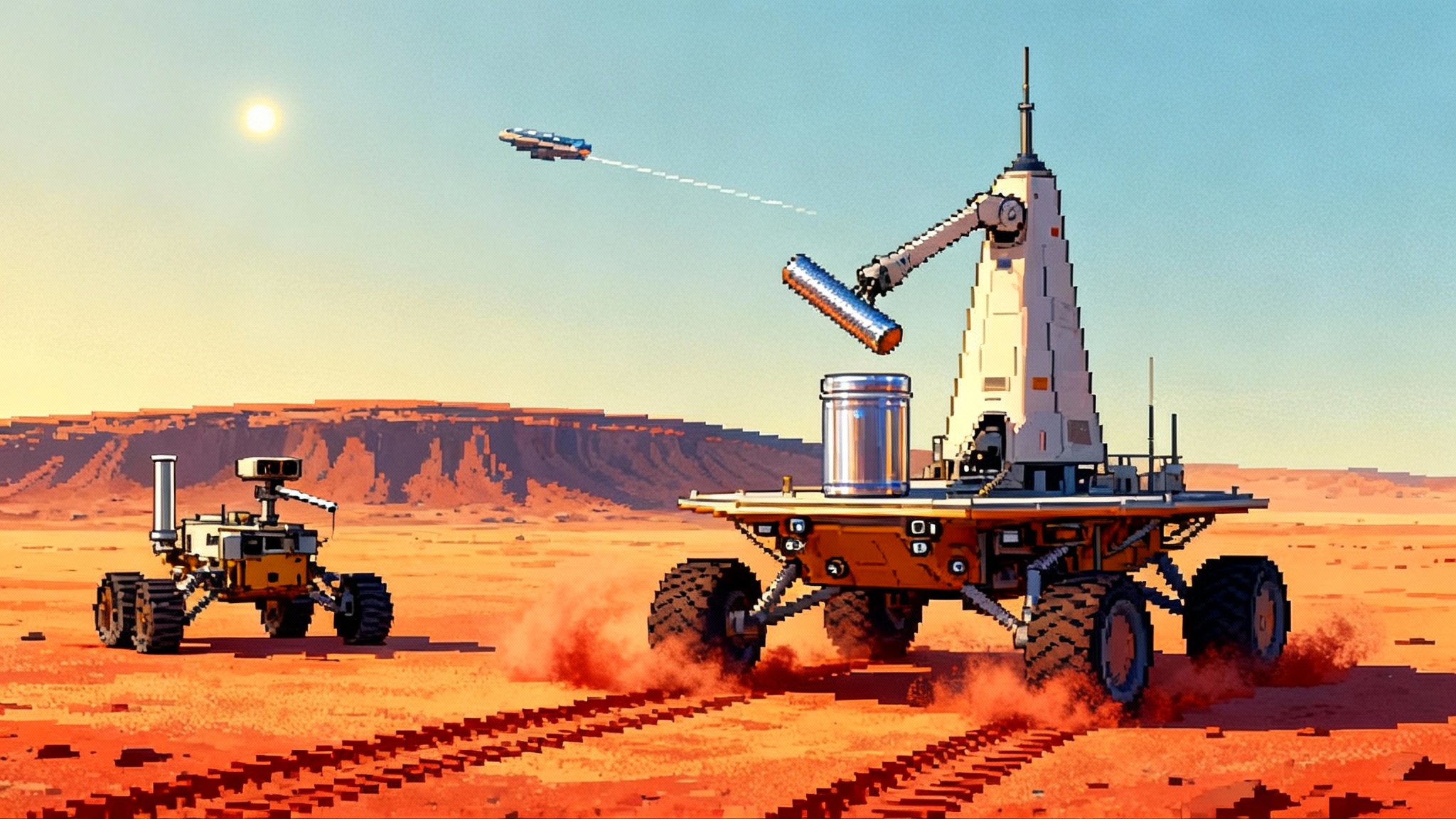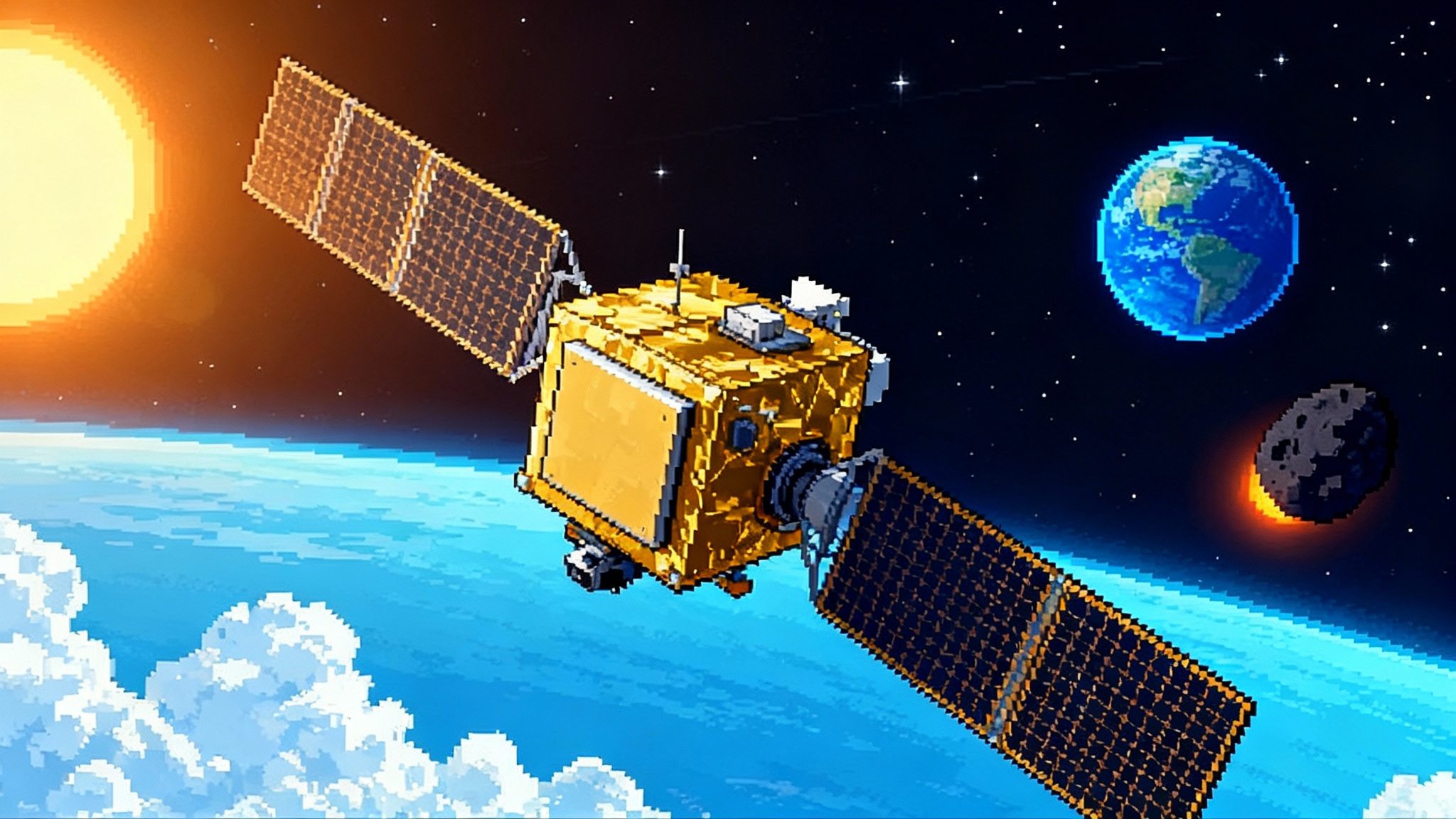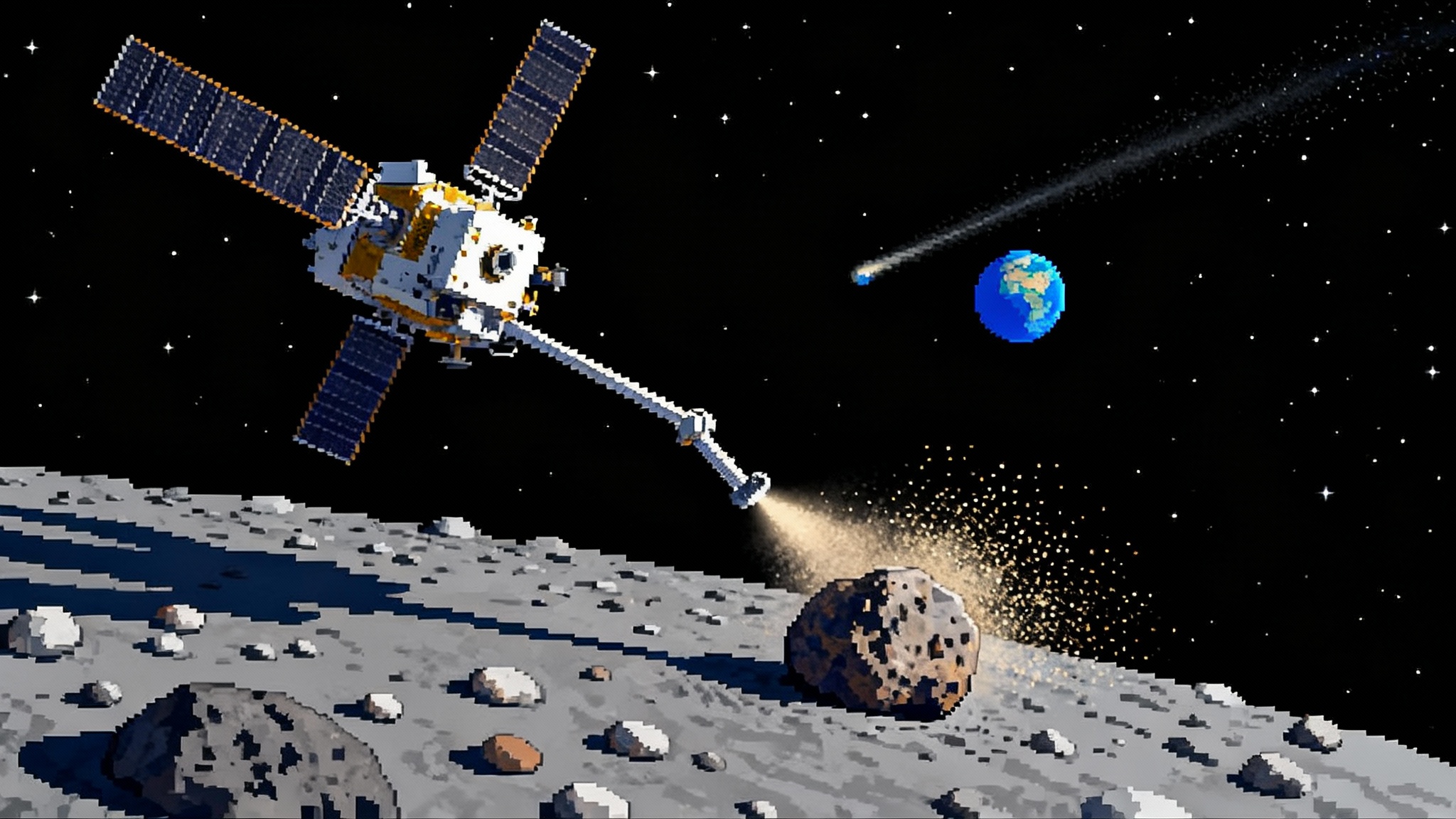Europa Clipper’s Mars flyby locks in its ocean toolkit
Europa Clipper turned a routine gravity assist on March 1, 2025 into a full-ops rehearsal, validating radar, thermal, and magnetic techniques it will use to probe Europa’s hidden ocean.

The slingshot that doubled as a dress rehearsal
On March 1, 2025, Europa Clipper threaded a tight curve around Mars, passing about 550 miles above the planet to steal a little of its orbital energy and fling itself toward the outer solar system. The maneuver, called a gravity assist, is standard celestial mechanics. What was not standard was how the mission used the moment. With the spacecraft already commissioned after launch and having deployed its magnetometer boom and its array of 12 radar antennas, the team treated Mars as a proving ground. Engineers and scientists turned on the instruments, ran real observing sequences, and watched the spacecraft behave as if Europa were already below. NASA later detailed the pass and its outcomes in JPL’s Mars flyby report.
This was not a victory lap. It was a live-fire test of the exact toolkit that must work when Europa is the target. The radar probed layered terrains to verify data clarity and signal power settings. The thermal imager scanned day and night boundaries to tune exposure times and temperature retrievals. The operations team rehearsed how to slew, point, and buffer data while maintaining a tight power budget and an unforgiving data rate. Any hiccup found near Mars is a hiccup that does not occur over an alien ocean.
Why Mars was the right test track
Mars is not Europa, but it is the best rehearsal stage available. The planet’s surface presents a geological sampler platter. Over volcanic plains, radar returns show smoother echoes. Over cratered highlands, the subsurface scatters more strongly. That contrast lets the team verify how the radar’s two frequencies interact with terrain and depth, then retune waveform choices so the instrument will switch cleanly among Europa’s ridges, chaos terrain, and smoother ice sheets. That focus on operational efficiency echoes the agency’s push for a faster Mars Sample Return reboot.
Thermally, Mars offers dramatic day to night swings. As the planet rotates, surface materials warm and cool at different rates. The thermal imager uses those differences to calibrate its ability to detect subtle temperature contrasts. On Europa, those contrasts will be the bread crumbs that help find cracks, recent resurfacing, and perhaps warm spots where the ocean communicates with the surface.
Mars also carries a wispy ionosphere and a busy plasma environment when the solar wind is active. That is a gift to the magnetometer and to the plasma instrument that flies alongside it. The plasma instrument senses charged particles that can distort magnetic readings. By seeing both at once, the team creates a clean picture of the magnetic field. That pairing is essential at Jupiter, where the planet’s changing magnetic field induces currents in Europa’s salty ocean. Untangling the magnetic signature of that ocean from the surrounding charged-particle storm will be one of the mission’s signature feats.
The ocean-hunting toolkit, piece by piece
Spacecraft get judged by the elegance of their systems and by the strength of their ensemble. Europa Clipper’s instruments were designed to overlap, cross-check, and de-risk one another. The Mars flyby turned those design intentions into practice.
Radar that reads ice like pages in a book
The radar package, known informally as the ice-penetrating radar, sends pulses at two frequencies. One dives deeper with less detail. The other captures finer vertical structure closer to the surface. Think of it like tuning two flashlight beams. One is broad and can illuminate a faraway cave. The other is narrow and highlights textures on the wall nearby. When the two are combined, the instrument can map layers, see buried interfaces, and estimate how much salt or trapped water might be present.
At Mars, the radar team used the planet’s varied surfaces as targets with known quirks to calibrate their processing pipeline. They verified how to suppress surface clutter, measured how much the ionosphere smears the radar’s phase, and confirmed that the flight software can adaptively adjust parameters when the terrain below changes rapidly. These dry runs mean that when Europa swings into view at tens of thousands of miles per hour, the instrument will already know how to behave.
Thermal vision tuned for faint warmth
Europa’s warmth is subtle. The thermal imager must catch differences of a few degrees over scenes that are frigid by terrestrial standards. During the Mars pass, the instrument scanned across the dawn and dusk line where temperature transitions are steepest. That allowed the team to validate the way it converts raw detector counts into absolute temperature. It also provided a catalog of noise sources like hot pixels and radiation hits and confirmed that planned exposure sequences will avoid saturating the detectors in bright scenes while still spotting faint warmth in darker areas.
The payoff at Europa could be significant. Thermal anomalies might trace the outlines of recently opened cracks or point to places where warmer water sits close to the surface. Sustained warm spots could flag active regions where plumes might erupt, which would in turn guide other instruments to take a closer look.
A magnetometer that can hear an ocean
Jupiter’s magnetic field sweeps past Europa like a conductor waving a baton. If Europa harbors a global salty ocean, that time-changing field induces currents within it. Those currents create a secondary magnetic field. Detecting that induced field and separating it from the background is how a magnetometer reveals the ocean’s presence and depth.
Europa Clipper deploys its magnetometer sensors on a boom to reduce interference from the spacecraft. It pairs the magnetometer with a plasma instrument that counts the charged particles surrounding the spacecraft. During the Mars flyby, the team practiced the algorithms that subtract spacecraft noise and correct for plasma effects. The result is a cleaner, more reliable magnetic signal when Europa is the target.
Spectrometers and cameras that triangulate chemistry
Although the Mars pass focused on radar and thermal performance, the team used cruise operations to begin early checkouts of the ultraviolet spectrograph and to confirm the imaging system’s timing and focus. The ultraviolet spectrograph is sensitive to plume signatures and to the gases that sunlight can tease out of the surface. Early calibrations help ensure that when the instrument looks at Europa’s limb or surface, it can distinguish a real spectral fingerprint from instrumental quirks.
The imaging system will provide the cartography that every other instrument depends on. Its job is not just to take pretty pictures. It must precisely geolocate features from flyby to flyby so that repeated observations build a physical story rather than a gallery of isolated snapshots. That job starts now, with timing, compression, and data-handling rehearsals that keep images and other datasets lined up to the pixel.
What 2025’s test-by-flyby already changes
Space missions de-risk themselves in two ways. They prove hardware and they prove operations. The Mars flyby assisted both.
- The radar team established noise and signal levels against real planetary backdrops, which locked in flight configuration choices that would be expensive to change later. That includes waveform tables, gain schedules, and radio-frequency interference filters.
- The thermal imager team tuned exposure sequences for day, dusk, and night and validated temperature retrieval algorithms end to end. That lets them design Europa observations that waste fewer seconds and return more usable frames per pass.
- The magnetometer and plasma teams tested cross-calibration routines that will be critical for interpreting induced fields at Europa. Doing this now reduces the chance of misreading ocean properties later.
- The spacecraft and navigation teams rehearsed attitude control, data buffering, and Deep Space Network handoffs under a real pointing and power profile. That training will pay off when the timeline compresses at Jupiter and every second of contact must count.
This is not guesswork. The mission has been releasing regular updates that outline the commissioning flow, early calibrations of the ultraviolet spectrograph, and the steps completed after launch. A May update summarized how the Mars flyby and subsequent checkouts gave the team confidence to finalize instrument configurations for cruise and to refine Europa encounter plans. For an accessible overview of that status and the science path ahead, see the ScienceDaily instrument update.
The road ahead: one more swing and the big arrival
The trajectory is set. After the Mars assist, Europa Clipper spends the next phase of cruise refining spacecraft performance and completing long-duration instrument runs. An Earth flyby in December 2026 adds the final energy needed to reach Jupiter on schedule. The current plan targets arrival on April 11, 2030. Once captured into Jupiter’s gravity, the spacecraft will not orbit Europa directly. Instead it will loop Jupiter in a wide orbit and perform dozens of close passes by Europa. That strategy reduces radiation exposure and spreads science returns over many encounters, creating a stitched-together global dataset.
Between now and the Earth flyby, expect more calibration campaigns. Instruments will stare at stars to validate pointing, track stable celestial targets to measure drift, and continue to practice the quick pivots required when a flyby demands rapid switching between instruments. The mission operations team will refine the cadence of downlinks to avoid bottlenecks and will simulate radiation-season scenarios so that the spacecraft can keep working even when Jupiter’s environment gets rough. For broader context on how launch cadence and mission economics are changing, see how Mars mission math with New Glenn is reshaping planetary timelines.
What success looks like at Europa
When flybys begin, success will look less like a single headline and more like a growing, interlocking story. The radar will map icy structures deep below the surface and flag places where layers bend or disappear. The thermal imager will check those places for warmth that suggests active processes. The magnetometer and plasma instrument will measure the ocean’s electrical properties to estimate its depth and salinity. Spectrometers will scan for gases or faint plumes that hint at a pathway from the ocean to space. Cameras will tie everything together so that every measurement has a precise home on the map.
That multi-instrument choreography is not redundancy for its own sake. It is method. For habitability, the question is not only whether there is water. It is whether there is energy, chemistry, and pathways that connect them. At Europa, that means heat sources that keep water from freezing solid, salts and organics that can circulate, and fractures that move material between the surface and the ocean. Each instrument watches a different part of that system. Together they can test whether Europa offers the ingredients and the plumbing that life would need.
How Mars rehearsal accelerates ocean-world exploration
Europa Clipper is not flying in a vacuum of ideas. It is part of a new playbook for exploring worlds with oceans beneath ice. Mars gave the mission a chance to run the playbook under pressure.
- By validating radar and thermal settings early, the mission reduces the number of Europa passes needed just to figure out how to observe. More passes can be devoted to targeted science, which shortens the path to answers.
- By locking in magnetic and plasma calibration routines, the mission increases confidence in derived ocean properties. That raises the value of each flyby for understanding habitability.
- By proving operations during a real planetary encounter, the team frees up schedule margin during the first months at Jupiter. That margin can be spent on opportunistic observations or on rapid responses if, for example, a plume is suspected.
These efficiencies do not only benefit Europa. The techniques will carry over to future missions to other ocean worlds, such as Enceladus. If a follow-on mission builds a radar to read ice or a spectrograph to sniff plumes, the Europa Clipper playbook will already include tested recipes for pointing, data compression, and cross-instrument timing. Mars accelerates that learning. For a complementary look at space-weather context that affects charged particles and operations, revisit our piece on the IMAP early warning stack.
What to watch next
- Earth flyby preparations in 2026. Expect updates on how the team will use the pass to verify navigation accuracy, communications margins, and instrument stability over another long cruise leg.
- Radiation-hard operations rehearsals. Look for news on how onboard autonomy will handle instrument safing and recovery in Jupiter’s harsh environment without losing precious flyby time.
- Targeting refinements. As gravity models and shape models of Europa improve, the mission can tweak closest approach points to cross key features such as chaos terrains and lineae at high science value geometries.
- Community data products. Anticipate announcements about how raw and calibrated datasets will be staged so that research teams can start building layered interpretations quickly once the first Europa flybys are complete.
The deeper implication
Space missions succeed not only by surviving the unknown but by turning it into practice. The March 1 flyby asked a practical question. Can the Europa Clipper hardware and team perform their most demanding tasks while the spacecraft is in the middle of a complex gravitational ballet. The answer appears to be yes. The pass turned Mars into a training ground, and the results are already shaping how the mission will use every minute at Jupiter.
When Europa finally fills the field of view in 2030, the challenge will not be whether the instruments work. It will be how creatively the team uses them to test hypotheses about ice, ocean, and energy. Thanks to a savvy test-by-flyby around Mars, that creative work can start on day one. In exploration, time is the most precious resource. The Mars pass just bought more of it.








